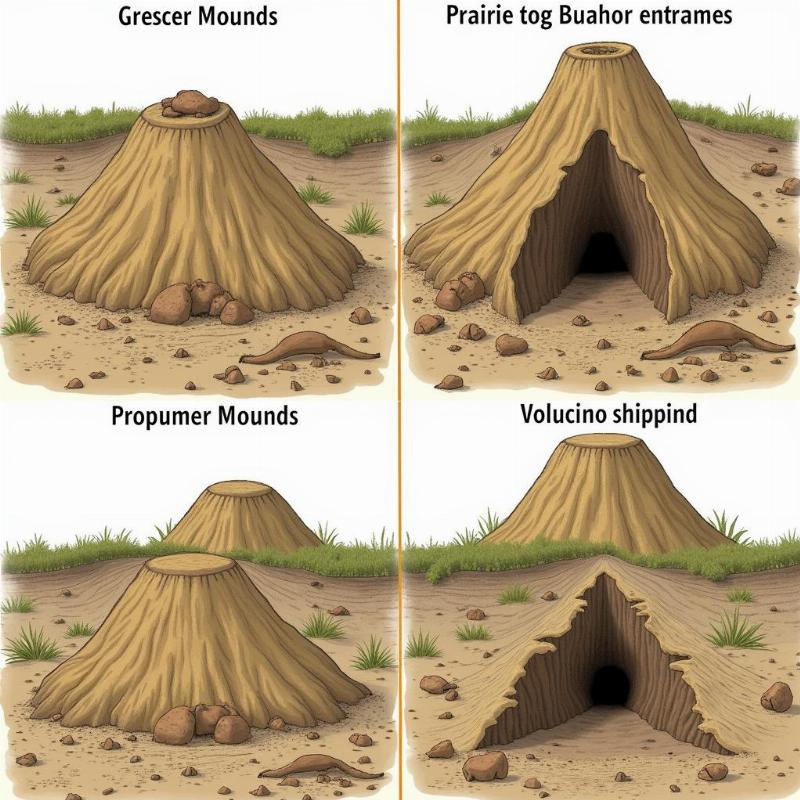Gophers and prairie dogs: two burrowing rodents that often get confused. While they share some similarities in habitat and appearance, there are key differences between a gopher and a prairie dog that distinguish them. Understanding these differences can be helpful for homeowners dealing with unwanted yard visitors, or for nature enthusiasts eager to identify these fascinating creatures. This article will delve into those distinctions, covering everything from physical characteristics to social behavior.
Physical Differences: Spotting the Telltale Signs
One of the easiest ways to differentiate between gophers and prairie dogs lies in their physical appearance. Gophers are generally smaller, with large, fur-lined cheek pouches used for carrying food. Think of them as miniature, furry chipmunks with buck teeth. These pouches are a defining feature, often visible even when the gopher is partially concealed. Prairie dogs, on the other hand, are larger and more stoutly built, resembling a chunky squirrel. They lack the prominent cheek pouches of the gopher.
Another key difference is their teeth. Gophers have large, protruding incisors that are always visible, even when their mouths are closed. Prairie dogs’ teeth are less prominent and not readily visible. Also, observe their tails: gophers have short, hairy tails, while prairie dogs have longer, more distinct tails, often with a black tip.
Habitat and Behavior: Different Lifestyles, Different Impacts
Both gophers and prairie dogs are burrowers, but their social structures and the way they impact the landscape differ significantly. Gophers are solitary creatures, living alone in their burrow systems. They are known for creating crescent-shaped mounds of dirt at the entrance to their burrows. These mounds can quickly multiply, becoming a nuisance for gardeners and homeowners.
Prairie dogs, however, are highly social animals, living in large colonies called “towns.” These towns can span acres and contain hundreds or even thousands of individuals. Their burrows have volcano-shaped entrances, creating a different landscape pattern than gopher mounds. They are known for their complex communication system, including a series of barks and chirps used to warn each other of predators.
 Gopher Mounds vs. Prairie Dog Towns
Gopher Mounds vs. Prairie Dog Towns
Dealing with Gophers and Prairie Dogs: A Homeowner’s Guide
If you find yourself with unwanted gophers or prairie dogs on your property, it’s important to take appropriate action. For gophers, best leash for reactive dogs trapping is often the most effective method. You can also try using repellents or modifying your landscaping to make it less attractive to them.
Prairie dog management can be more complex due to their social nature and the size of their colonies. Relocation might be necessary, but it’s crucial to consult with local wildlife authorities as regulations vary by state.
Are Gophers and Prairie Dogs Dangerous?
While both gophers and prairie dogs are generally harmless, they can pose certain risks. Gophers can cause significant damage to gardens and lawns, while prairie dogs can transmit diseases, such as plague, although this is rare. Both can also become a tripping hazard due to their burrows.
Conclusion: Recognizing the Rodent Residents
Understanding the difference between gophers and prairie dogs is essential for effective management and appreciation of these unique creatures. By recognizing their distinct physical characteristics, social behaviors, and the impact they have on the environment, we can coexist peacefully and appreciate their role in the ecosystem.
FAQ:
- What is the main difference between a gopher and a prairie dog? Gophers are solitary and have cheek pouches, while prairie dogs are social and lack pouches.
- Do gophers and prairie dogs live in the same areas? They can share similar habitats, but their burrows and social structures are different.
- How can I tell if I have gophers or prairie dogs in my yard? Look for crescent-shaped mounds for gophers and volcano-shaped mounds for prairie dogs.
- Are prairie dogs dangerous to humans? While generally harmless, they can transmit diseases in rare cases.
- What should I do if I have gophers or prairie dogs on my property? Contact local wildlife authorities for guidance on safe and effective removal or relocation.
- Do gophers and prairie dogs hibernate? Gophers don’t hibernate, but prairie dogs enter a state of reduced activity during winter.
- What do gophers and prairie dogs eat? Gophers primarily eat roots and vegetation, while prairie dogs eat grasses and other plants.
Beautdogs.us is your one-stop shop for all things dog-related in the United States. We offer expert advice on dog breeds, care, and products, catering to both novice and experienced dog owners. Beautdogs.us is a trusted resource for ensuring the well-being of your furry friend. Contact us today for all your dog-related needs! Email: [email protected], Phone: +1 501-555-7529.